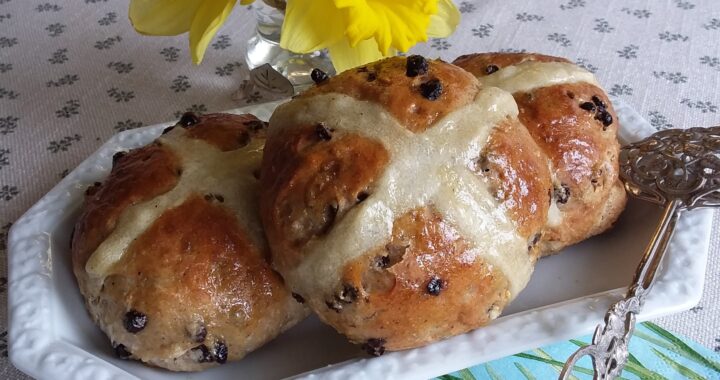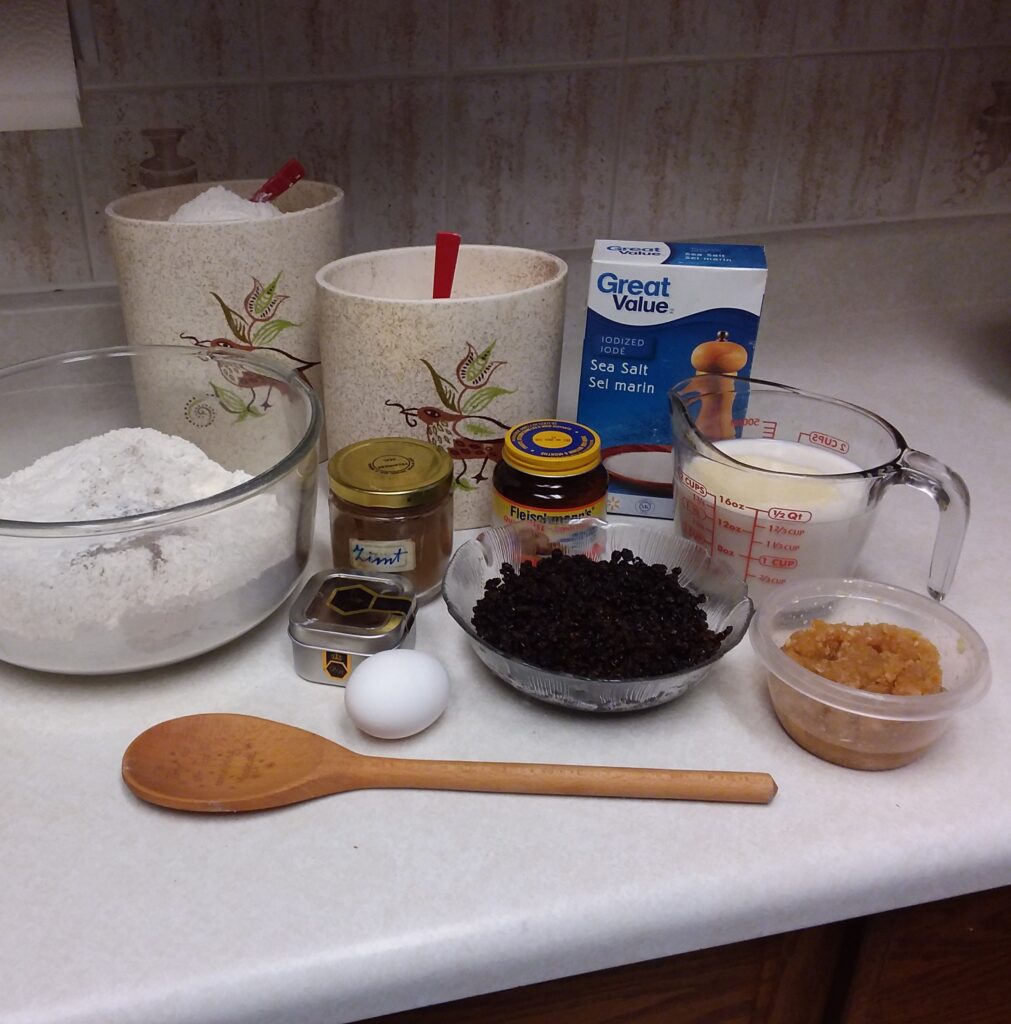 Hot Cross buns have a long history, that includes magic, healing, protection and connects us through many cultures to the circle and the cross.
Hot Cross buns have a long history, that includes magic, healing, protection and connects us through many cultures to the circle and the cross.
The first references to a similar bun was in ancient Greek and Roman times where they were an offering to Diana, Goddess of the hunt. As Rome extended out across Europe, this tradition most likely came along and was then transferred to the Saxon goddess of spring and dawn, Eostre.
The buns were taken on board ships to prevent shipwrecks. They were hung in the kitchen for a year! to protect against evil, help with the baking and prevent fires. They were even mixed with hot water and given to the sick to help them heal.
There have been several reasons given for the medieval ban on Hot Cross buns. One was that the queen did not like shortcut pastry, the then standard material used for the cross. Another was that they were considered sacred and therefore should only be allowed on special days such as Good Friday, Christmas and funerals. I might be reaching a little but I would go with an ongoing wish to change the narrative from a pagan one to a Christian one. When something as popular as fruit buns is in the public consciousness, changing the story and connections take time. Think about chocolate eggs in 2024. How many generations would it take for us to no longer know the traditions associated with them today?
For many Hot Cross bun history begins with the crucifixion of Christ. The cross represents the cross upon which he died, the spices, a nod to the embalming methods used at the time and orange to reflect his bitter time on the cross.
You will need:
4 1/4 cups flour (more on that later)
1 Tbsp. instant yeast
1/2 cup sugar (as fine a grain as you have on hand)
2 tsp. cinnamon
2 tsp. allspice or a mixed combination of warming spices
3/4 tsp. salt
1 1/2 cups warmed milk
1/4 cup melted butter
1 egg
1 cup sultanas or currants
1/3 cup finely chopped fruit peel
crosses:
1/2 cup flour
5 Tbsp. water
glaze:
honey, maple syrup, thinned apricot jam or thinned orange marmalade
Take a moment before beginning to open to your intention. Whatever your intention is for these buns, be fully connected to your reasons. “Love is work in action” is a saying in the Findhorn community that conveys this blending of open heart with planned actions. As you wash your hands, left go of the troubles of the day, allowing the nigglies to drain off your fingertips and the water leaves your hands, making it way down the drain. Close your eyes, be still and take several deep breathes, holding and releasing. When you feel ready begin.
The process for making these buns is simple but a few ideas will help the outcome. Firstly, bring any cold items into the kitchen and let them warm up. My extra flour was in the garage and was therefore cold. Not a good idea when keeping yeast happy. The same goes for the egg.
Secondly, if you have doubts about the viability of the yeast test before combining. In this recipe, the yeast goes directly into the dry ingredients and all will be lost if the yeast has gone off. Pop a pinch in some gently warm water with another pinch of sugar and check for proof of life in about five minutes. There should be bubbles.
Thirdly, this recipe can be made with all purpose or bread flour. Bread flour is the North American name for strong flour, which you will often find in British recipes for scones and buns. Strong flour is made from hard wheat, has a higher gluten content and therefore binds together more easily. It is also possible to opt for a 50/50 combination of all purpose and bread flour.
Keep your kitchen warm, not so warm it is difficult to work in but this time of the year there can still be a cooler edge to the room and yeast likes warm spaces.
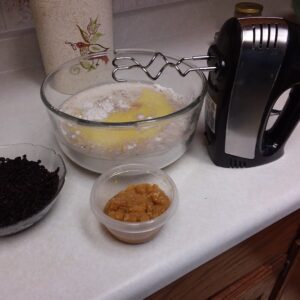 Combine the dry ingredients; 4 cups flour, sugar, spices and yeast. Stir to combine.
Combine the dry ingredients; 4 cups flour, sugar, spices and yeast. Stir to combine.
Leave out the last 1/4 cup to add in at the end if needed.
Pour the milk into a small pot and add the butter, place over a medium heat and stir occasionally until the butter is melted. A microwave is also an option. Put aside to cool a little before adding the egg and stirring to combine.
Add the wet ingredients to the dry and stir together. The stirring can be via dough hooks or hand mixer beaters or by hand.
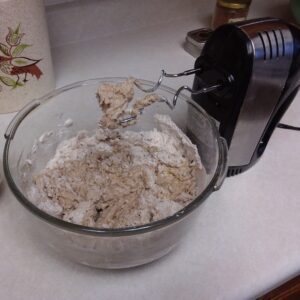 Mix until the dough has come together and then turn out onto a flour dusted surface and knead. If you stared with dough hooks, this will take about five minutes and if the kneading is done by hand, closer to ten. This is a great time to just relax and enjoy the rhythm of movement, letting the gluten create elasticity. If the dough is too sticky then by all means add the extra flour. Too much and the buns will become stiff, so remember please just enough that the dough is not constantly sticking to your hands.
Mix until the dough has come together and then turn out onto a flour dusted surface and knead. If you stared with dough hooks, this will take about five minutes and if the kneading is done by hand, closer to ten. This is a great time to just relax and enjoy the rhythm of movement, letting the gluten create elasticity. If the dough is too sticky then by all means add the extra flour. Too much and the buns will become stiff, so remember please just enough that the dough is not constantly sticking to your hands.
Spread the dough out enough to have enough space to add the fruit on top. Pull the edges together and continue kneading to distribute the dried fruit.
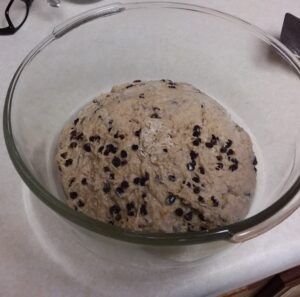 The traditional choice in Britain, in years past, would have been dried black currants as the weather on the island was not great for growing grapes and therefore having raisins locally available. The climate is also one of the reasons mead and ale was made more often than wine.
The traditional choice in Britain, in years past, would have been dried black currants as the weather on the island was not great for growing grapes and therefore having raisins locally available. The climate is also one of the reasons mead and ale was made more often than wine.
Today, raisins are easy access for most people in many countries and are the preferred choice. If your choice is black currants, I would suggest pouring a little hot water over the fruit, allowing the berries to soak up the moisture and soften. If there is a little remaining water, use it up in the dough and reduce the volume of milk.
Once the batter has come together, put it in an oiled bowl, cover and place in a warm area, away from drafts for about an hour, until the dough has doubled in size. The length of time needed will depend on the warmth of the place it is sitting.
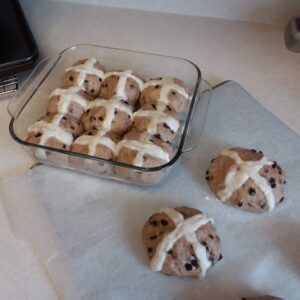 When the dough had doubled, punch it down, turn it out onto a floured surface and knead a few times to get any extra air out of the dough.
When the dough had doubled, punch it down, turn it out onto a floured surface and knead a few times to get any extra air out of the dough.
Roll the dough out into a long even log and cut into 12 – 15 equal width slices.
Now there is a choice to be made. If you like your buns with soft sides, then into an oiled 9 x 13 pan will go 12-15 balls of dough. These buns will be square once baked as they will grow to fill the baking pan.
If you would like round buns then place them in a larger pan or on a parchment lined cookies sheet that will give the buns more space to grow without touching another bun.
The choice is yours but here is the story I learned growing up. The original tradition was the round bun. It was gifted on spring equinox morning and was symbolic of the Wheel of Life and cardinal directions. It was also a reference to the four phases of the moon. It has been suggested that just like cutting the top of soda bread “to let the fairies out”, creating the cross allowed for the breaking of the buns into four sections for sharing. Dried fruits being a highly prized ingredient a millennium ago. The square buns came into being when the ban on making Hot Cross buns commercially was lifted as it was possible to fit more buns in the pan.
Form the buns on or in the baking container of your choice. Cover and let sit in a warm location until they have again doubled in size.
As mentioned, original crosses were made from shortcrust pastry dough. The common choice these days is a flour and water combination while some people chose to make an orange flavoured icing that is added once the buns are cold. Again the choice is yours.
Preheat the oven to 350 degrees F.
To make the flour paste combine 1/2 cup of flour with 5 Tbsp. of water. Once well combined, transfer to a piping bag or sandwich baggie. Close the bag and clip a small tip or corner to pipe the mixture onto the top of the buns. Do this gently following along the curve of the buns, running first in one direction and then the other. It is sticky and will get easier to be more uniform with practice.
Bake at 350 degrees for about 22 minutes. Remove from the oven when nicely browned and brush with your choice of glaze. It can be warmed honey, apricot jam thinned with a small amount of hot water, maple syrup or orange marmalade also thinned with hot water to make it easier to spread.
Now here comes the hard part. LET THEM COOL. Give the buns enough time to fully cool. It will make them easier to cut and serve the buns. Too warm and they will simply squish together. These buns also toast up really well if there are any left over the next day.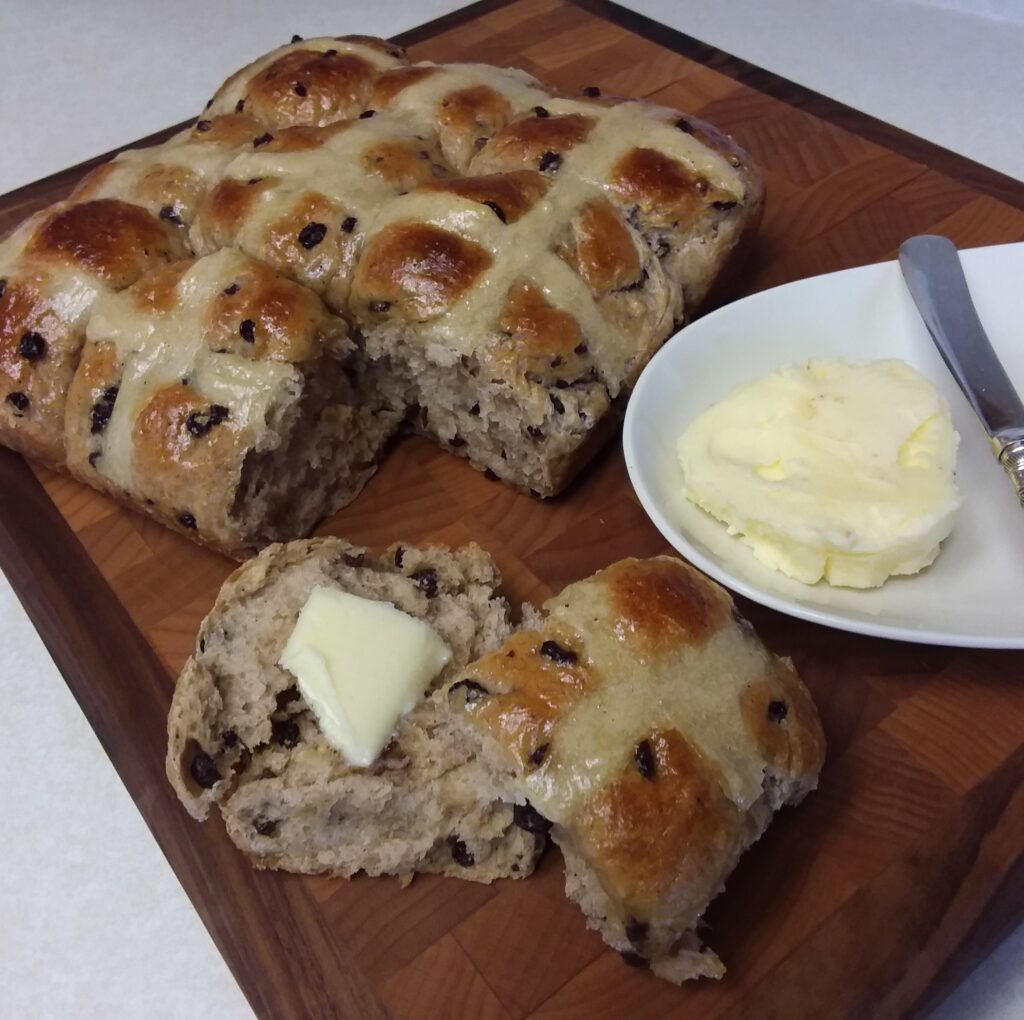 Square or round, these buns and its variations are made the world over at this time of year. Whether it is to celebrate the beginning of a new year, the end of Lent, the turning of the seasons or the crucifixion, they have managed over centuries to still be an important part of the season.
Square or round, these buns and its variations are made the world over at this time of year. Whether it is to celebrate the beginning of a new year, the end of Lent, the turning of the seasons or the crucifixion, they have managed over centuries to still be an important part of the season.
When these buns were sold on the streets of London, one of the earliest recorded hawking calls to people was, “Good Friday comes this month, the old woman runs, With one or two a penny hot cross buns.” When I hear this, I think of Cailleach finally going away at the end of her battle with Brigid, winter having once more lost to spring. There are many other variations, even songs written, with many of the words changed but this is the earliest version I have found.
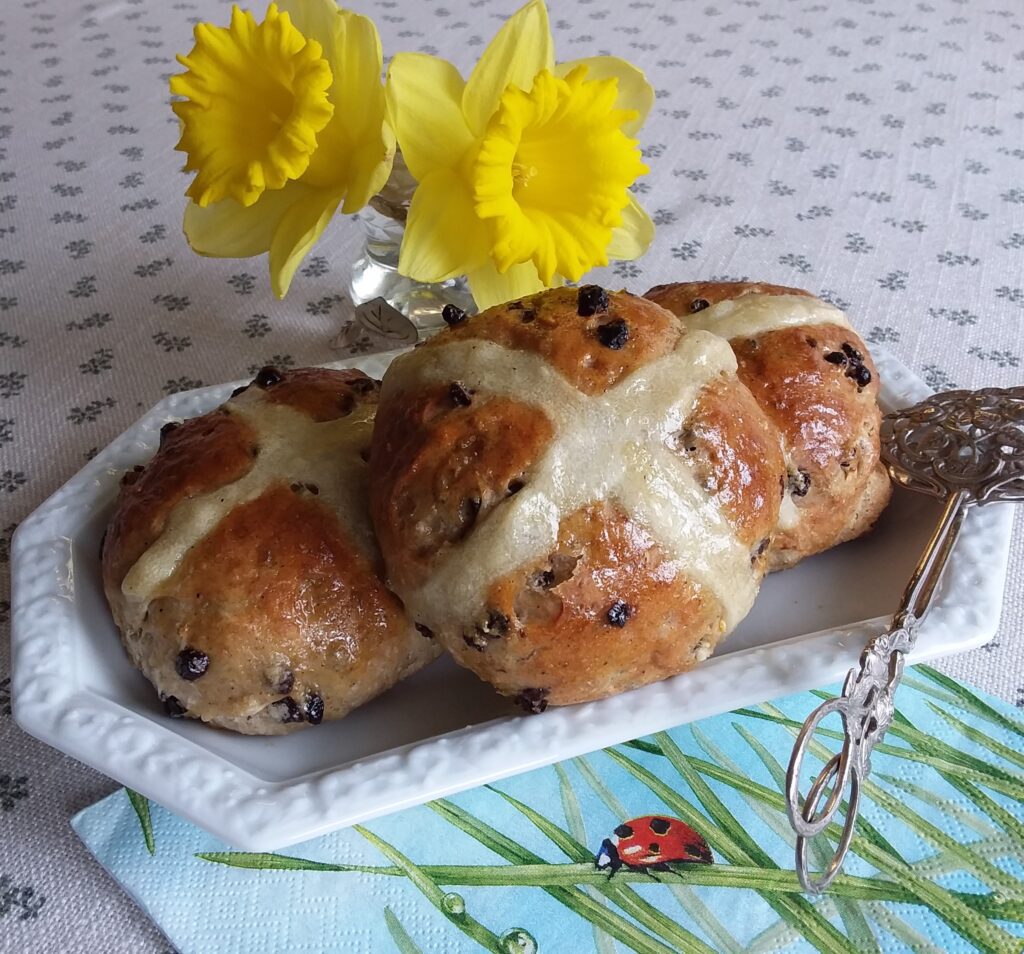 Hot Cross buns from My Kitchen Wand
Hot Cross buns from My Kitchen Wand

